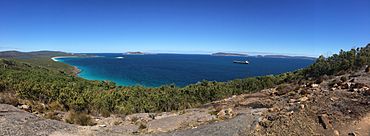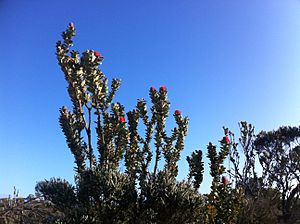Gull Rock National Park facts for kids
Quick facts for kids Gull Rock National ParkWestern Australia |
|
|---|---|
|
IUCN Category II (National Park)
|
|

King George Sound from Gull Rock National Park
|
|
| Nearest town or city | Albany |
| Established | 2006 |
| Area | 21.04 km2 (8.1 sq mi) |
| Managing authorities | Department of Environment and Conservation |
| See also | List of protected areas of Western Australia |

Gull Rock National Park is a special protected area in Western Australia. It's a national park located about 25 kilometers (16 miles) southeast of Albany. This park was created in 2006. It became the 97th national park in Western Australia. The park covers an area of about 2,593 hectares (6,407 acres).
Contents
Where is Gull Rock National Park?
Gull Rock National Park is surrounded by beautiful natural features. To the south, you'll find King George Sound. Oyster Harbour is to the west. Taylor Inlet is on the park's eastern side. Farmland borders the park to the north.
The park gets its name from a small island. This island is located off Ledge Beach. However, the island itself is not part of the national park. Boiler Bay is also found at the eastern edge of Ledge Beach.
Close to the park's western border is the Mount Martin Botanical Reserve. The Two Peoples Bay Nature Reserve is also nearby. It is about 10 kilometers (6 miles) to the east of Gull Rock National Park.
What Makes the Park Special?
Gull Rock National Park is a wonderful example of coastal vegetation. It shows what the Kalgan area looked like before much change. The park has granite headlands, which are rocky cliffs. These headlands are separated by sandy beaches. You can also find lakes and interdunal wetlands here. Wetlands are areas where water covers the soil.
The park has many different types of ecosystems. These are communities of living things and their environment. Rocky granite areas are present, including Mount Taylor and Mount Martin. These mountains are part of a larger landform unit called Gardner.
The varied landforms and soils create many different homes for plants and animals. The park is a mix of forests, woodlands, and wetlands. You can also see areas of sedges, granite shrublands, and coastal heath. This rich variety supports a large number of plant species.
Animals and Plants of Gull Rock National Park
Gull Rock National Park is home to many amazing creatures and plants. Some of these species are very rare or endangered. This means they are at risk of disappearing forever.
Endangered Birds and Mammals
Several endangered birds live in the park. These include the noisy scrub-bird, the western bristlebird, and the western whipbird. These birds are very special and need protection.
The endangered Western ringtail possum is also often seen here. This small mammal is a type of possum. It is important to protect their habitat.
Rare Plants and Flowers
Many rare plant species grow in the national park. These include Corybas limpidus and Stylidium plantagineum. You can also find Adenanthos cunninghamii here. Another rare plant is Banksia verticillata.
The park features different plant communities. There are areas of banksia woodland and sheoak forest. You can also explore open heath and grassed dunes.
Some notable plants include Banksia coccinea, also known as scarlet banksia. Other plants are Hakea elliptica and Allocasuarina trichodon. You might also see Agonis marginata and Dryandra formosa.
Gull Rock National Park has the most important remaining groups of scarlet banksia in the region. However, these plants are threatened by a disease called Phytophthora dieback. This disease can kill plants.
Coastal Heath and Sedgeland
On the lower parts of Mount Taylor, you'll find Melaleuca striata coastal heath. In this area, Melaleuca striata, Banksia attenuata, and Banksia coccinea grow. Their growth is often stunted. This is because of the salty air from the coast.
Anarthria scabra is very common in the sedgeland areas. Sedgelands are wet areas with grass-like plants called sedges. Other plants found here include Adenanthos cuneatus and Astroloma baxteri. You can also see Hypocalymma strictum and Hypolaena exsulca. Isopogon cuneatus, Lyginia barbata, Melaleuca thymoides, and Petrophile rigida are also present.
The Main's Assassin Spider
A survey in 2008 found a rare and ancient spider in the park. This spider is called the Main's assassin spider. It is currently listed as a threatened species. This means it is at risk of extinction. Protecting its home in the park is very important.




